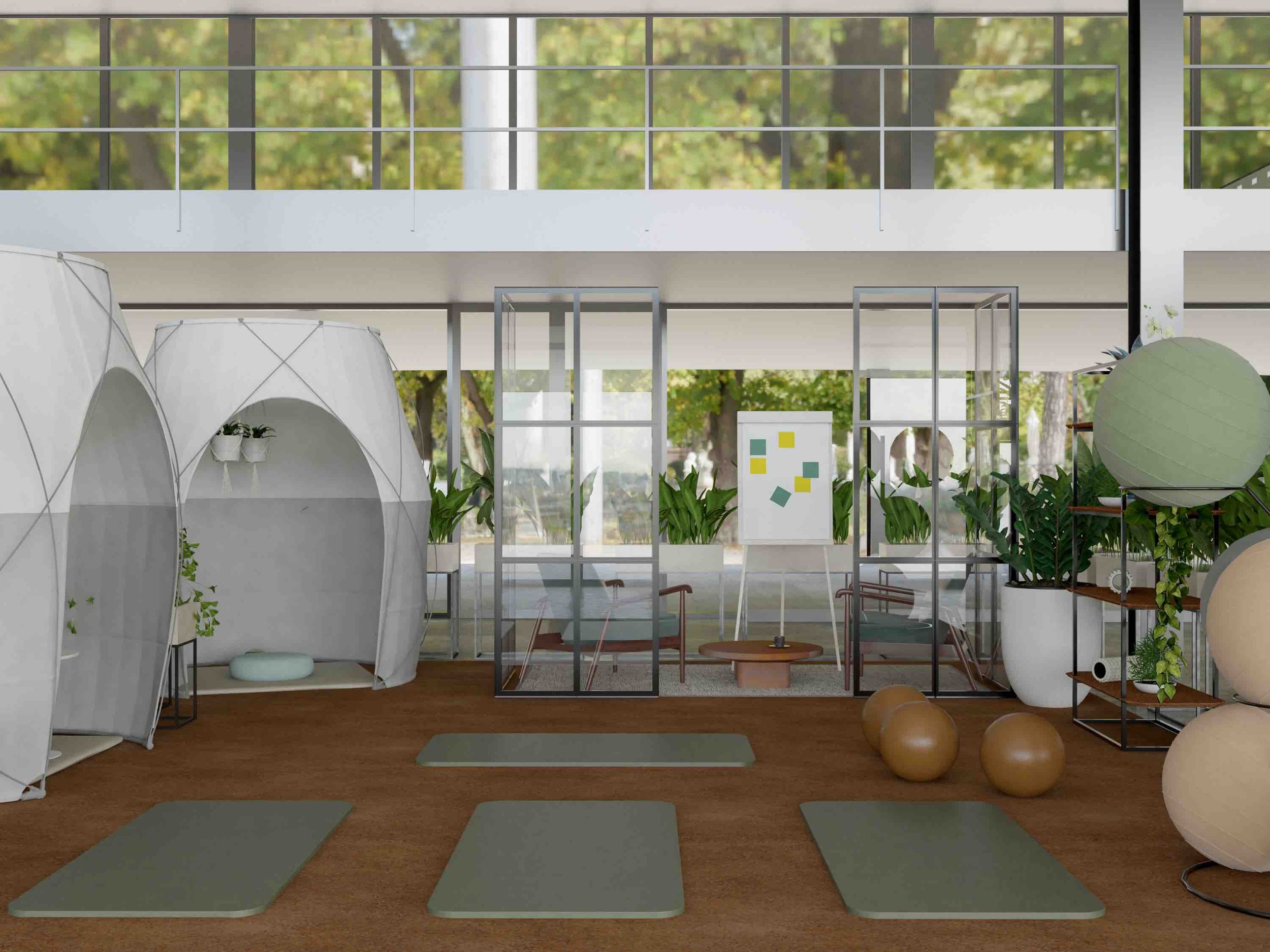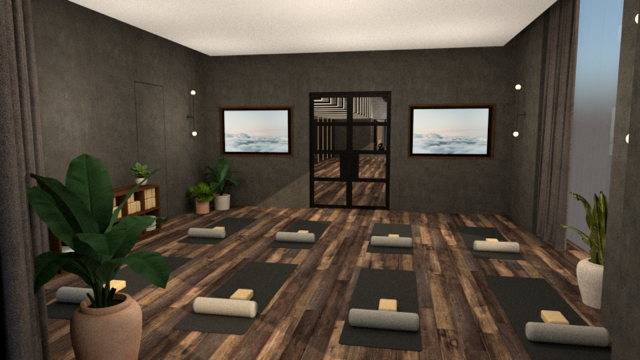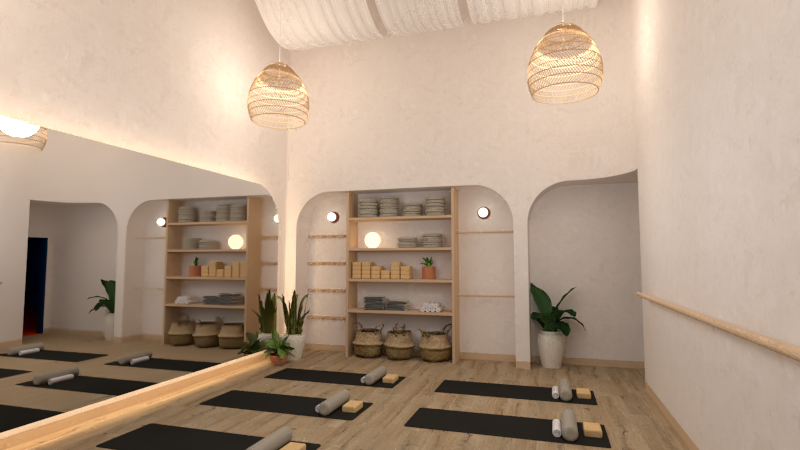Mastering Serenity: A Designer's Guide to Innovative Yoga Studio Design
yoga space by biofit for Goldkern, Munich
As the demand for yoga practice spaces continues to grow, so does the need for highly differentiated wellness studio design, be that in hotels, resorts, residential developments or offices.
This article will explore the importance of applying wellness interior design concepts such as biophilic design to yoga studios, as well as the key design principles behind a successful mind-body movement space from our perspective.
Introduction to yoga studio design
Yoga studio design, unlike say a personal training studio design concept, is all about creating a space that fosters relaxation, focus, and tranquility while accommodating the needs of various mind-body practices.
A well-designed yoga studio should provide the perfect environment to encourage practitioners to fully immerse themselves in their practice, be it yoga, pilates, barre, dance or meditation.
By considering factors such as layout, wellness lighting, color schemes, and decor, designers can create a space that not only meets the functional requirements of a yoga space but also promotes a sense of serenity and well-being.
The importance of a well-designed WELLNESS SPACE
A thoughtfully designed space can of course help to create a welcoming atmosphere that encourages practitioners to feel at ease and focus on their practice but as healthy building and wellness interior experts, we believe it can go beyond that in promoting overall health (see more below).
Furthermore, it can help to differentiate a hotel, workspace or residential development in a competitive market, attracting clients and eventually even fostering a loyal community of practitioners.
By investing in innovative yoga studio design therefore, hotel owners, residential developers and even offices can create a space that not only meets the needs of their users but also provides an environment that a wellness studio promotes mental wellbeing.
yoga studio / wellness studio design by biofit
Key elements of innovative yoga studio design
When it comes to yoga studio design, our experience in gym design and leisure space design shows us there are several key elements to consider in order to create a space that is both functional and aesthetically pleasing. These include:
Layout
The layout of a yoga studio should allow for ample space for practitioners to move freely and exercise comfortably, without feeling cramped or restricted. Consider the size and shape of the room, as well as the placement of windows and doors, when planning your layout.
Lighting:
Lighting plays a significant role in setting the ambiance in yoga studios and rooms. We aim to create a calm, restorative environment by incorporating a combination of abundant natural light (when available) and soft, warm artificial lighting.
Large windows, skylights, and the use of sheer curtains can help bring in natural light, while dimmable LED lights and strategically placed lamps can provide the necessary illumination for evening sessions without being intrusive.
Acoustics:
Acoustics are another important aspect of the interiors and operations of yoga spaces. Sound-absorbing materials like cork flooring or acoustic panels can help reduce external noise levels and create a more serene atmosphere for practice. Additionally, incorporating a high-quality sound system for playing curated music playlists or guided meditations can further elevate the yoga experience.
Ventilation:
A well-ventilated space is essential for maintaining a comfortable environment for practitioners, particularly in hot yoga studios. Consider incorporating windows that can be opened, as well as an efficient HVAC system to ensure optimal air quality and temperature control.
Accessibility:
A safe and successful yoga studio should be accessible to all, regardless of physical ability. Ensure that your space is wheelchair accessible and includes facilities such as ramps and accessible restrooms.
yoga studio / wellness studio design by biofit
Designing for different types of yoga practices
As yoga continues to grow in popularity, so too does the variety of wellness practices available. When designing a yoga studio, it's important to consider the specific needs of the different types of yoga that will be offered.
Hot yoga studio designs
Hot yoga, such as Bikram and Hot Vinyasa, requires access to a space with temperature and humidity controls to maintain the ideal environment for practice.
In addition to ventilation and HVAC systems, hot yoga studios should also incorporate moisture-resistant materials and surfaces to prevent damage and promote their health and cleanliness.
Flooring options like vinyl or rubber can provide a non-slip surface that is easy to clean and maintain.
Traditional yoga studio designs
Traditional yoga studios, which may offer practices such as Hatha, Iyengar, or Ashtanga, typically require a more serene and calming environment.
In these spaces, natural materials and earthy tones can help to create a peaceful atmosphere that promotes mindfulness and relaxation.
Consider incorporating wood or bamboo flooring, as well as soft, muted colors for walls and decor.
Adequate wall space is also essential for practices that involve body inversions or the use of props like ropes and blocks.
Multi-purpose yoga studio designs
For studios that offer a variety of movement practices such as barre, dance, pilates or perhaps even personal training, a flexible design is key as is a suitable range of equipment stored neatly on the perimeter walls.
Yoga studio interior design ideas
To create a space that is both functional and visually appealing, consider the following design elements:
Color schemes and lighting
When choosing a color scheme for your yoga studio, opt for calming and soothing shades that promote relaxation and focus.
Soft, muted colors like pale blues, greens, and grays can help to create a tranquil environment, while warm earth tones like beige, brown, and terracotta can evoke a sense of grounding and stability.
In terms of lighting, natural light is ideal for creating a serene atmosphere, but also consider incorporating adjustable lighting options like dimmable fixtures or soft, ambient lamps.
Flooring and wall treatments
For flooring, consider materials that are both comfortable underfoot and easy to maintain, such as wood, bamboo, or cork.
Wall treatments can range from simple, painted surfaces to more elaborate options like decorative plaster or textured panels.
Consider incorporating elements like mirrored wall, which can be helpful for practitioners to check their alignment and posture during practice sessions.
Furniture and storage solutions
A well-organized yoga studio should include ample storage solutions for props, equipment, and personal belongings, we cannot emphasize the importance of this point enough!
Consider incorporating built-in shelves, cabinets, or cubbies for storing items like mats, blocks, and bolsters, as well as designated areas for coat and shoe storage.
Furniture should be kept to a minimum in order to maintain a clutter-free floor space for movement (or stillness rather!).
Yoga studio decorating ideas
Here are some yoga studio decorating ideas to inspire your design:
Artwork and wall decor
Incorporating artwork and wall decor can help to create a visually appealing and inspiring environment for yoga practice.
Choose pieces that reflect the principles of yoga and mindfulness, such as images of nature, mandalas, or inspirational quotes.
Be mindful of the scale, weight and placement of artwork, ensuring that it does not detract from the overall serenity of the space.
Plants and natural elements
Including plants and natural elements (biophilia) in your yoga studio design can help to create and strengthen a sense of connection with nature and promote feelings of tranquility and grounding.
Consider incorporating potted plants, like ferns or succulents, as well as elements like water features or natural stone accents.
For more on green exercise, see here.
Creating focal points and meditation spaces
Create focal points within the space by incorporating elements like altars, statues, or large-scale artwork.
Additionally, consider providing comfortable seating options like floor cushions or meditation benches to encourage practitioners to linger and reflect.
BIOPHILIC DESIGN IN YOGA STUDIOS
The incorporation of plants and other natural elements in the interiors of yoga spaces can help create a sense of connection to the outdoors and promote overall wellbeing. This can be achieved through the use of natural materials like cork, wool, linen, wood and stone, as well as the addition of plants and water features.
VIRTUAL TRAINER SOFTWARE APPS
Incorporating a projector or large plasma screen on one wall with virtual trainer software can give us a fully automated schedule of classes each day, or access to in-depth meditation, mindfulness, breathwork and movement practice guided videos via apps such as OPO or OPEN.
Working with professional designers and architects
While it's possible to tackle a yoga studio design project on your own, working with a professional designer such as Biofit can help to ensure that your space is both functional and aesthetically pleasing.
As wellness design professionals have the expertise to guide you through the design process, helping to bring your vision to life while addressing important factors like layout, lighting, and acoustics.
Additionally, we can help to navigate any building codes or regulations that may apply to your project, ensuring that your yoga studio meets all necessary requirements.
Conclusion: creating your dream yoga studio
In summary, designing a beautiful and functional yoga studio requires careful consideration of factors like layout, lighting, and materials, as well as an understanding of the specific needs of various yoga practices.


